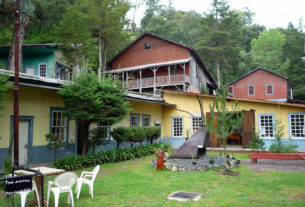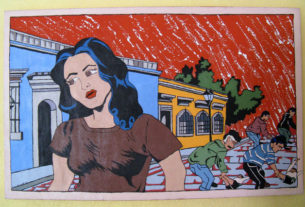Mexico City is one of the world’s largest urban centers, and its population continues to grow at a rate unequaled by any other area in the nation. The Mexico City region has long been the center of economic and political activity in Mexico. The area where the City lies today has been a center of politics, finance and religion since pre-Hispanic times. Many see the city as the economic and as the political center of Latin America as a whole.
Today the Historic Center, the very heart of Mexico City, is in a sadly dilapidated state; its population is diminishing while architectural deterioration, pollution, and crime increase. Fortunately, after many years of decline, renovation and revival aimed at improving the lives of those that live and work in the area, appear to have begun.
The Historic Center
After their conquest of Mexico in 1521, the Spaniards settled their capital on the ruins of the old Aztec capital. They soon began construction of their great palace and a great cathedral in their main plaza, now called the Zocalo. These buildings were the center of religious and political activities and are still important today. The president of Mexico still maintains offices here, in the National Palace.
This downtown plaza also quickly became an important center of social activity. According to Exquiel Ezcurra, of the National Institute of Ecology, “The plazas and markets in general, and the city’s zocalo in particular, became the axis of colonial life, the public arena where social classes faced each other, the place of encounter where Aztec and Spanish elements began mixing slowly into a new culture.” Since colonial times, this area has been site of great activity and a meeting place for those from different walks of life.
Today, Mexico City’s population has been estimated at around 30 million, and it continues to grow at a pace unequaled in the rest of the country. This growth has moved much of the city’s commerce away from the Historic Center and, partly as a result, the Zocalo area has fallen into a state of decay. In fact, the Zocalo has been under the protection of UNESCO’s World Heritage Program since 1988.
However, this decay is not just a product of population growth. Another destructive factor has been changes in the area soil. Such a great amount of water has been removed from the ground that the soil has contracted, buckling streets and sidewalks throughout the city, and hitting the downtown area particularly hard. One striking example is the sunken ruins of an Aztec temple called the Templo Mayor. The Templo Mayor was destroyed just after the Spanish conquest; when its ruins were uncovered in 1978, it was twenty-feet below the plaza and titled at a 30 degree angle. The Metropolitan Cathedral, situated next to the Templo Mayor, is also sinking and tilting. Only after nearly 10 years of restoration has it been removed from the World Monuments Fund list of the 100 Most Endangered Sites. As increasing numbers of buildings are sinking, tilting, and cracking, more and more residents decide to abandon the area.
Pollution in the area is another major problem. A steady stream of traffic clogs main streets. Not only is it sometimes uncomfortable to breathe the air downtown (for some, it can sting the eyes and throat), but the pollution has also taken a toll on area buildings. Gas emissions from cars, combined with pollutants from industry and natural factors like wind and rain, have also increased the rate at which many buildings in the Historic Center are deteriorating.
Many locals also consider the Historic Center to be an unsafe area and they do not feel safe travelling in the area, particularly in the evening, when the streets are dark. The area is known as a site of prostitution, vandalism, and robbery.
The Renovation
After numerous aborted government plans, Carlos Slim, widely known as the wealthiest businessman in Latin America, was recently appointed by Mexico’s president and Mexico City’s mayor to head a new effort to breathe life into this area. According to Slim, “We want to create a vibrant cultural scene with more entertainment venues, theaters and cinemas alongside the plazas, churches and Mexican traditions.”
It is hoped that this new effort will put the area on track for large-scale international tourism, which could greatly improve the local economy. The Zocalo, which already attracts a large number of tourists, is to be refurbished with new green spaces, lighting, fountains and benches. Several other plazas in the Historic Center are also being renovated. Vizcainas Plaza, which is home to a colonial convent, has recently seen the reopening of its theater, and is being landscaped. Renovation of commercial areas in the plaza have also begun. Many plazas, like Santo Domingo and Tolsá Plazas, and many streets like Tacuba and Callejón Condes are also benefitting from new lighting projects to better illuminate historic monuments and improve evening visibility, which should help make the area more secure.
In all, more than eighty 18th and 19th century buildings will be restored, but Carlos Slim comments that “It is not just about restoring old buildings. We want to inject life into the area so that more people study, work, and live there.” Many of the buildings that are being restored will be designed as live-work space, with apartments placed above commercial space. It is hoped that increasing the number of apartments and commercial spaces will attract people to the area. Many new homes are also being built, thousands of them at mid-range rental prices. Credit programs will be extended to attract more families to the area.
Though this renovation plan is just getting underway, early results can already be seen; for the first time in recent memory there is optimism about the possibilities that lie ahead for the Historic Center. Much work and many challenges lay ahead. As Carlos Slim has repeatedly pointed out, this project represents the beginning of a commitment that the government and citizens must make if this important area is to be preserved.
The Future
As a result of the renovation efforts in Mexico City’s Historic Center, tourism may rise and boost the economy. More of the city’s families may live in safer and cleaner conditions. The whole country will benefit from the preservation of these rich remnants of the past, so that present and future generations may be able to appreciate the cultural landmarks and historical artifacts that still remain.
“Those of us that live in this boundless metropolis recognize in the Historic Center the mark of time, the sedimentation of the collective memory, the expression of the creative talent of other epochs…” – Maria Teresa Franco, General Director of the National Institute of Anthropology and History


